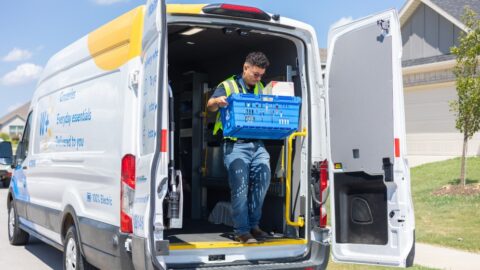Already focused on burnishing its public image via better treatment of employees, Walmart is now moving to sustainability and local product sourcing as its next positive courses of action. The retailer laid out an environmental roadmap in which the company would get 50% of its energy from clean and renewable sources by 2025.
Thus far, Walmart has put an emissions reduction plan in place that has been approved by the Science Based Targets Initiative, in accordance with the Paris Climate Agreement of December 2015.
Doug McMillon, CEO of Walmart, revealed the retail giant’s full slate of commitments at the Net Impact Conference, held Nov. 3-5 in Philadelphia. By 2025, Walmart plans to:
Advertisement
-
Double the amount of local produce it sells in U.S. stores;
-
Expand and enhance sustainable sourcing to cover 20 key commodities, including bananas, grapes, coffee and tea;
-
Achieve zero waste to landfill in the U.S., UK, Japan and Canada;
-
Reduce emissions in its own operations by 18%; and
-
Reduce product and packaging waste and preserve natural resources, making Walmart’s private brand packaging 100% recyclable.
The emphasis on local product sourcing comes as the retailer continues its ongoing commitment to accelerating the growth of U.S. manufacturing. In 2013, the retail giant pledged to purchase an additional $250 billion in products made, sourced or grown in the U.S. by 2023.
After years of criticism and complaints from various labor and environmental organizations for its business practices, it appears Walmart is making strides to improve both its own working environment and its position as a representative of social good. Walmart is likely recognizing that younger consumers, particularly Millennials and Gen Z-ers, are more likely to shop at retailers that stand for good causes or contribute to charity. Given the increasing awareness spreading in regards to retail brands that have been taking more philanthropic stances in recent years, Walmart had very little choice but to adapt and shed some of its corporate stigma.
For example, Walmart’s decision to bump its entry level salaries to as high as $10 per hour in January 2016 cost the retailer $2.7 billion, so there definitely is a concerted effort to put bottom-line resources into problem areas.
“Do customers care?” said McMillon during the conference. “In our experience, there are a lot of customers who do. Over time, they’re becoming more sensitive and aware of what they’re buying and their impact on the world.”
The brand’s actions are also significant because Walmart has such tremendous reach and impact that its decisions can affect the entire industry. Other retailers may find themselves needing to build out their own sustainability initiatives in order to keep up with the Bentonville giant.














